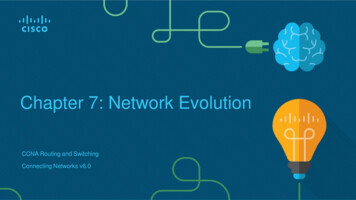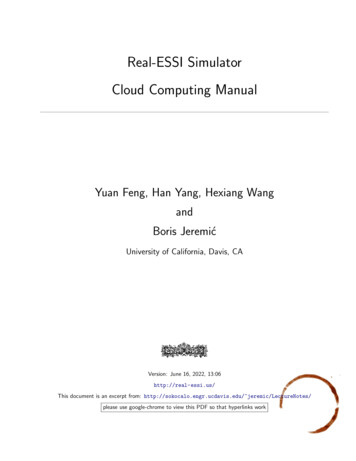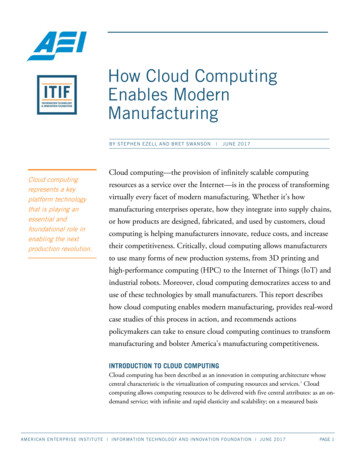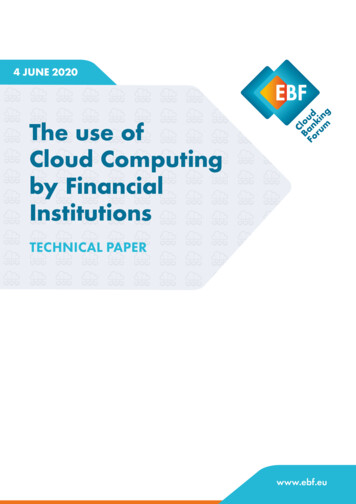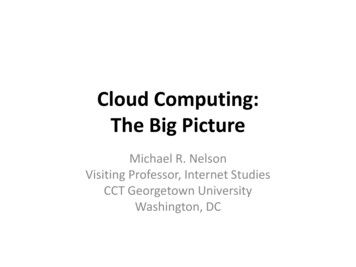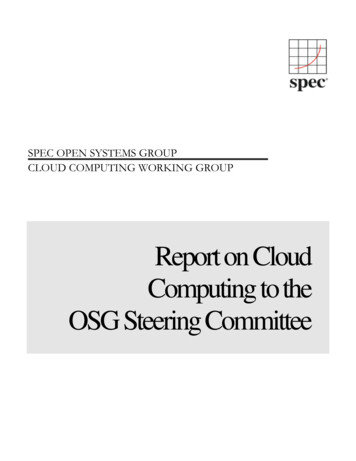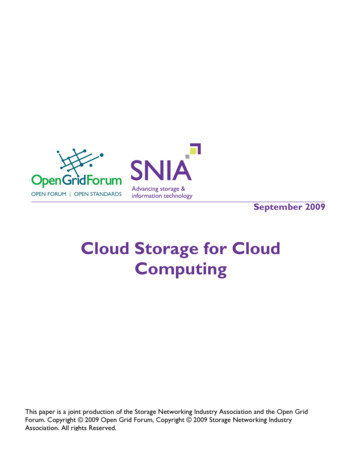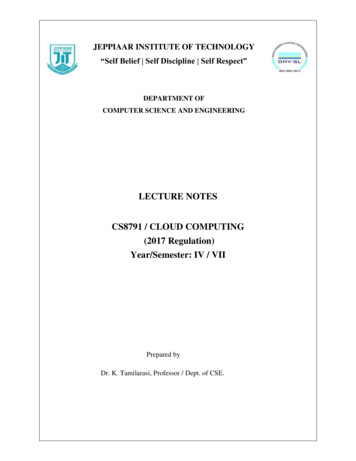
Transcription
Data Centers and Cloud ComputingData Centers Large server and storage farms– 1000s of servers– Many TBs or PBs of data Intro. to Data centers Used by Virtualization Basics– Enterprises for server applications– Internet companies Some of the biggest DCs are owned by Google, Facebook, etc Intro. to Cloud Computing Used for– Data processing– Web sites– Business appsComputer ScienceLecture 22, page 2Inside a Data CenterComputer ScienceLecture 22, page 3MGHPCC Data Center Giant warehouse filled with: Racks of servers Storage arrays Cooling infrastructure Power converters Backup generators Data center in HolyokeComputer ScienceLecture 22, page 4Computer ScienceLecture 22, page 5
Modular Data CenterVirtualization .or use shipping containers Each container filled withthousands of servers Can easily add new containers Virtualization: extend or replace an existing interface tomimic the behavior of another system.– “Plug and play”– Just add electricity– Introduced in 1970s: run legacy software on newer mainframehardware Allows data center to be easilyexpanded Pre-assembled, cheaperComputer Science Handle platform diversity by running apps in VMs– Portability and flexibilityLecture 22, page 6Types of InterfacesComputer ScienceLecture 22, page 7Types of OS-level Virtualization Different types of interfaces– Assembly instructions– System calls– APIs Type 1: hypervisor runs on “bare metal” Type 2: hypervisor runs on a host OS Depending on what is replaced /mimiced, we obtaindifferent forms of virtualization Emulation (Bochs), OS level, application level (Java,Rosetta, Wine)Computer ScienceLecture 22, page 8– Guest OS runs inside hypervisor Both VM types act like real hardwareComputer ScienceLecture 22, page 9
Virtualization in Data CentersServer Virtualization Virtual Servers Allows a server to be “sliced” into Virtual Machines VM has own OS/applicationsVM 1 Rapidly adjust resource allocationWindowsVM 2Linux– Consolidate servers– Faster deployment– Easier maintenanceVirtualization Layer VM migration within a LAN Virtual DesktopsWindowsLinux– Host employee desktops in VMs– Remote access with thin clients– Desktop is available anywhere Work– Easier to manage and maintainHomeComputer ScienceLecture 22, page 10Computer ScienceData Center ChallengesLecture 22, page 11Data Center Costs Resource management Running a data center is expensive– How to efficiently use server and storage resources?– Many apps have variable, unpredictable workloads– Want high performance and low cost– Automated resource management– Performance profiling and prediction Energy Efficiency– Servers consume huge amounts of energy– Want to be “green”– Want to save moneyComputer /CostOfPowerInLargeScaleDataCenters.aspxLecture 22, page 12Computer ScienceLecture 22, page 13
Economy of ScaleWhat is the cloud? Larger data centers can be cheaper to buy and run thansmaller ones– Lower prices for buying equipment in bulk– Cheaper energy ratesRemotely availablePay-as-you-goHigh scalabilityShared infrastructure Automation allows small number of sys admins to managethousands of servers General trend is towards larger mega data centers– 100,000s of serversAzure Has helped grow the popularity of cloud computingComputer ScienceLecture 22, page 14The Cloud StackComputer ScienceLecture 22, page 15PaaS: Google App EngineSoftware as a ServiceOffice apps, CRMHosted applicationsManaged by providerPlatform as a ServiceAzurSoftware platformsInfrastructure as a ServiceServers & storageComputer SciencePlatform to let you runyour own appsProvider handlesscalabilityRaw infrastructureCan do whatever youwant with itLecture 22, page 16 Provides highly scalable execution platform– Must write application to meet App Engine API– App Engine will autoscale your application– Strict requirements on application state “Stateless” applications much easier to scale Not based on virtualization– Multiple users’ threads running in same OS– Allows google to quickly increase number of “worker threads”running each client’s application Simplescalability, but limited controlComputer ScienceLecture 22, page 17
IaaS: Amazon EC2Public or Private Rents servers and storage to customers– Uses virtualization to share each server for multiple customers– Economy of scale lowers prices– Can create VM with push of a B68.4GBPrice 0.02/hr 0.17/hr 2.10/hrStorage 0.10/GB per month– Don’t want to share CPU cycles or disks with competitors– Privacy and regulatory concerns Private Cloud– Use cloud computing concepts in a private data center Automate VM management and deployment Provides same convenience as public cloud May have higher costBandwidt 0.10 per GBhComputer Science Not all enterprises are comfortable with using public cloudservicesLecture 22, page 18 Hybrid ModelComputer ScienceProgramming ModelsCloud Challenges Client/Server Privacy / Security– Web servers, databases, CDNs, etc– How to guarantee isolation between client resources? Batch processing Extreme Scalability– Business processing apps, payroll, etc– How to efficiently manage 1,000,000 servers? Map Reduce Programming models– Data intensive computing– Scalability concepts built into programming modelComputer ScienceLecture 22, page 19– How to effectively use 1,000,000 servers?Lecture 22, page 20Computer ScienceLecture 22, page 21
Data Centers Large server and storage farms -1000s of servers -Many TBs or PBs of data Used by -Enterprises for server applications -Internet companies Some of the biggest DCs are owned by Google, Facebook, etc Used for -Data processing -Web sites -Business apps 3 Computer Science Lecture 22, page Inside a Data Center



